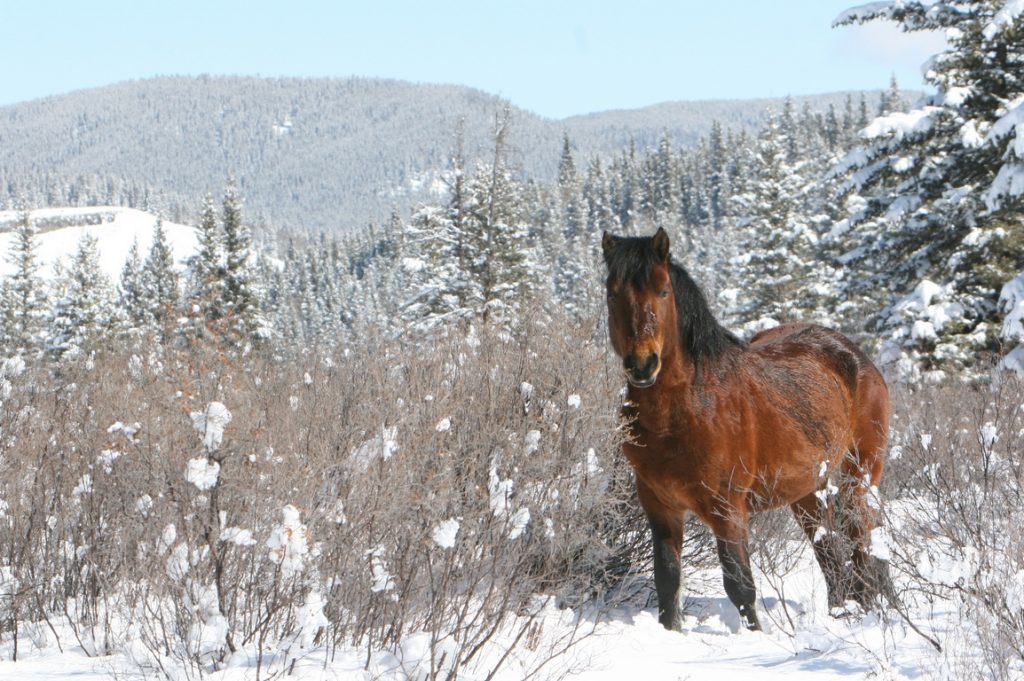
Wild horses do it, deer do, perhaps wild bees don’t do it but most creatures forage in the winter and so can you. Photo by the Wild Horses of Alberta Society
It’s rather obvious that wintertime foraging varies where you live. In moderate Florida we can forage all year and the wintertime provides some of the best opportunities. But what of northern climates?
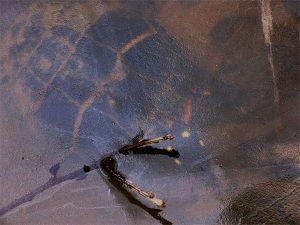
An edible turtle under ice. Photo by Richard Due.
I grew up where winter night temperatures easily dropped into the 30-plus below zero (-38 celsius.) Sometimes the schools had to close for several days because they could not be kept warm. And once we went skating at 50 below just to say we did. (Chilblains from that night some 60 years ago still bother me in air conditioned buildings. It’s wasn’t the skating with a bonfire that did permanent damage but rather the arctic one-mile walk home.) That was on Gowen’s Pond, our local natural skating rink. It had one tree-stump island, probably had been a water-tolerant hackmatack. That speck of protrusion through the ice was perhaps six square feet in total area. The ice was thinner there and one winter I saw a turtle under the ice feeding some some green pond plant. That generated several thoughts. One was that it was warm enough for the turtle to go looking for food. Two that the turtle found food, and, three that the turtle was food even in the winter. Like the turtle or the horses I grew up with you can find food in hostile winter climates if you know where to dig or browse. You can read more about that here.
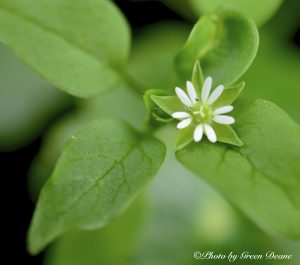
Chickweed have five petals that look like ten Photo by Green Deane.
Chickweed stole the show this weekend. In well-watered spots chickweed was in green glory, lush, full, blossoming, happy to be alive. With such healthy plants it was easy to find the identifying characteristics: stretchy inner core, a single line of hair on the main stem that switches 90 degrees at the nodes, a five-petal blossom that looks like 10 petals, and uncooked chickweed tastes like raw corn. Also sprouting patches of green on the monoculture brown park were stinging nettles. It’s still early in the season for nettles with most of them no higher than four inches, just about the same height as our winter henbit also available for the picking. A private forage later on produced, surprisingly, some native mint and a lot of true thistles. Lot’s of food and flavor there. There were also ticks-a-plenty.
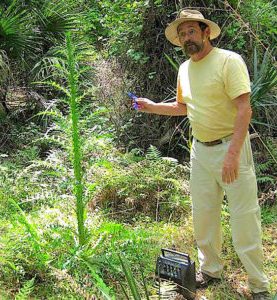
Foraging classes are held rain or shine, heat or cold. Photo by Nermina Krenata.
I’m teaching at a Mensa regional gathering in Cocoa Beach this Saturday afternoon so I am having a class in Melbourne Saturday morning. Sunday we are squeaking in a class in Jacksonville before really cold weather sets in next week.
Saturday, January 18th, Wickham Park, 2500 Parkway Drive, Melbourne, FL. 9 a.m. to noon. Meet at the Dog Park inside the park.
Sunday, January 19th, Florida State College, south campus, 11901 Beach Blvd., Jacksonville, 32246. 9 a.m. to noon. We will meet at building “D” next to the administration parking lot.
For more information, to sign up for a class, or to pre-pay go here.
The spate of warm weather recently increased our wanderings. Here are some of the bounty we found in foraging classes: natal plum, swinecress (which we later found there) some and a couple of Milkweed Vine fruit. While we nibbled on many things among them were Turks Cap, Oxalis, Black Nightshade (see below), Violets, False Hawk’s Beard, Plantagos, Fireweed, and Hairy Bittercress which is barely hairy at all. Also noticed during the forage was a tasty False Roselle not yet done in by the cool weather. And although the Eastern Red Bud won’t flower in profusion for couple of months we found a couple of winter-daring blossoms to look at.
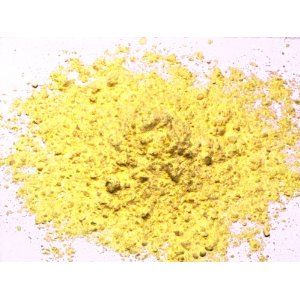
Use sublimed sulfur to thwart tick attacks.
Before the state of Florida went on the Internet most of the information it thought fit for its citizens to know was produced in pamphlet form. When the shift was made to the Internet some information got lost or was dropped. One useful bit of advice was using sublimed sulfur to keep ticks off. Available online or through local pharmacies or chemical supply stores you put it in an old sock or the like and dust your cuffs and collar with it before entering tick habitat. It either repels them or vastly slows them down from finding a place to grab on, giving you more time to find the hardy ones (to reduces chances of disease you should remove them within 24-hours. After that the chances of disease goes up exponentially with each passing hour.) I used sublimed for many years very successfully finding a tick or two on me now and then but not attached. That’s the good news. Now the bad news, for me at least. While I am not a biochemist I would suspect this would not be something you would do if you had a sulfur allergy. Indeed, after I used it for many years I developed an allergy to it (severe nasal congestion and eye watering.) So be careful. That’s said it did work well while I used it.
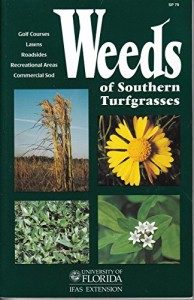
Weeds of Southern Turf Grasses
If you didn’t find a weed book you wanted under the Christmas tree here’s one you can pick up locally or order. The University of Florida has put out an unintentional edible weed book, Weeds of Southern Turfgrasses. What I mean is the book is not designed for foragers but rather land managers. However, the majority of the plants in the book are edible. It has 437 color photographs of 193 weed species found in the south usually on lawns and the like. As you can see by the link I have a list of the edibles and what pages they are on. Many of my students just print the list then paste each entry on the appropriate page or make notes on that page. There is also a link on the page to order it through the state of Florida. DO NOT ORDER IT THROUGH AMAZON OR OTHER BOOKSELLERS. Why? Because they will charge you from $38.67 to $59.66 for a book you can buy at a local extension office for $8. If you order it through the link I provide it is $14 plus shipping. (I actually found one bookseller in the past asking over $800 for it.) As it says on the link I do not get any money for recommending this book. It is just an inexpensive, handy book to have.
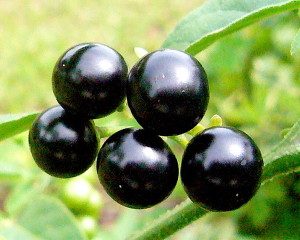
The Black Nightshade has berries.
I had a friend who thought of himself as an outdoorsman thus beyond needing to study edible plants. Many years ago he called me one day asking “how do I get the seeds out of the pigweed berries.” I knew there was a problem immediately. Our local “pigweed” does not have berries but our local nightshade does. Our “pigweed” is an Amaranth and has seed spikes. About the size of fingers or more they are covered with tiny flowers that produce a multitude eye-of-the needle seeds, tan to black. No berries involved at all. Conversely the nightshade (Solanum americanum) produces an umbrella-like spread of black shiny berries on one small stalk (photo to left.) It does have a lot of seeds inside the berries. So I thought I had better ask him why he wanted the seeds before I told him him the Amaranth didn’t have berries but the nightshade did. He wanted to grow some in his yard. They had been steaming the leaves and eating them like spinach! When I got done explaining he said “then that’s why we’ve all been getting headaches after eating the leaves.” Indeed. The leaves of this particular nightshade are edible but they must be boiled in one or two changes of water, not steamed.
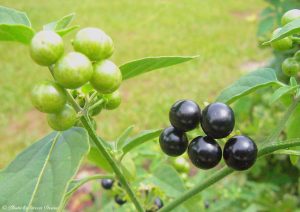
The American Nightshade can have totally ripe and unripe berries at the same time. Photo by Green Deane.
My friend had skipped many details. The wrong identification also led to the wrong preparation compounding the error. Admittedly the plants did have a few things in common. They were both green, grew in Florida and had leaves that can vaguely be the same rough shape, diamondish. But the difference between a seed spike of small green flowers vs. a cluster of shiny black berries is not paying attention to details. Fortunately no great harm was done. No matter how much Details are important (even though it is my personality to dislike them.) Locally two plants you will commonly encounter that you need to know about are the edible elderberry and the deadly water hemlock. To the beginner they can look similar. To learn important details about them and how they differ click here.
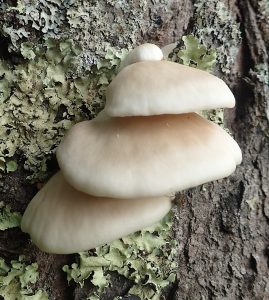
Oyster Mushrooms. Photo by Green Deane
Most local edible mushrooms are in winter recess. Our Ringless Honey Mushroom season ended several weeks ago. Most of our terrestrial species will stay hidden until heavy spring rains. However during a foraging class this weekend we did see some Amanitas, of which there is no shortage of in the southeast. It was three examples of the same species, A. citrina. But the big find but not a winter surprise was were logs of Oyster Mushrooms, of the Pleurotus ostreatus complex. They say “complex” because the mushrooms can vary enough for mycologists to notice but not enough to be called a different species. I’ve seen them on Oaks in the winter as well as Sweet Bays and Sycamores. In warmer weather I see a related smaller species on palms. Oyster Mushrooms — which do not taste like oysters but can smell like anise — are considered one of the safer mushrooms to harvest because none of the possible look-a-likes are deadly… just sickening. And here’s a reminder that several facebook mushroom pages are associated with EatTheWeeds. They are Florida Mushroom Identification Forum, Southeastern U.S. Mushroom Identification, Edible Mushrooms: Florida, Edible Wild Mushrooms, and the Orlando Mushroom Group.

The Nine DVD set includes 135 videos.
Though your foraging may drop off during the winter it’s a great time to study wild edibles with my nine DVD set. Each DVDs has 15 videos for 135 in all. They make a great gift. Order today. Some of these videos are of better quality than my free ones on the Internet. They are the same videos but many people like to have their own copy. I burn and compile the sets myself so if you have any issues I handle them personally. There are no middle foragers. And I’m working on adding a tenth DVD. To learn more about the DVDs or to order them click here.
 Donations to upgrade EatTheWeeds.com have gone well. Thank you to all who have contributed to either via the Go Fund Me link, the PayPal donation link or by writing to Green Deane POB 941793 Maitland FL, 32794. There are many needs left such as expanding the foraging teacher page, the page on monotypic edibles and the Plant Archive page. There’s always something and such things get more complex and expensive every year.
Donations to upgrade EatTheWeeds.com have gone well. Thank you to all who have contributed to either via the Go Fund Me link, the PayPal donation link or by writing to Green Deane POB 941793 Maitland FL, 32794. There are many needs left such as expanding the foraging teacher page, the page on monotypic edibles and the Plant Archive page. There’s always something and such things get more complex and expensive every year.
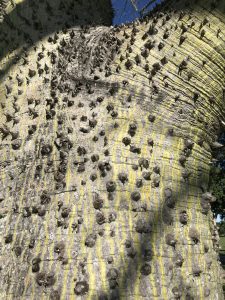
Do you know this tree with edible parts? You would if you read the Green Deane Forum
Want to identify a plant? Perhaps you’re looking for a foraging reference? You might have a UFO, an Unidentified Flowering Object, you want identified. On the Green Deane Forum we — including Green Deane and others from around the world — chat about foraging all year. And it’s not just about warm-weather plants or just North American flora. Many nations share common weeds so there’s a lot to talk about, such as the one to the left. There’s also more than weeds. The reference section has information for foraging around the world. There are also articles on food preservation, and forgotten skills from making bows to fermenting food. Recent topics include: Asystasia gangetica aka Chinese Violet or Ganges Primrose, Armillaria mellea Ringed Honeys, Acorn Treatment Question, Acorn Questions Any Poisons? A Cure For The Common Cold, Lactifluus piperatus, Elderberry Capers? You can join the forum by clicking on the button on the upper right hand side of this page.
This is weekly newsletter 388, If you want to subscribe to this free newsletter you can find the sign-up form in the menu at the top of the page.
To donate to the Green Deane Newsletter click here.


I thoroughly enjoy your newsletter, packed with information and so well-written. Just wanted to comment on the tick/sulfur bit. More years ago than I care to think about, the Girl Scout camp in Central Florida had the campers dust their socks as you mention. I proved to be allergic, evidence being large itchy welts! It recurred a few years later when a doctor prescribed a sulfur-based shampoo for skin issues. I would suggest people try a skin test before extensive use. Happy foraging!